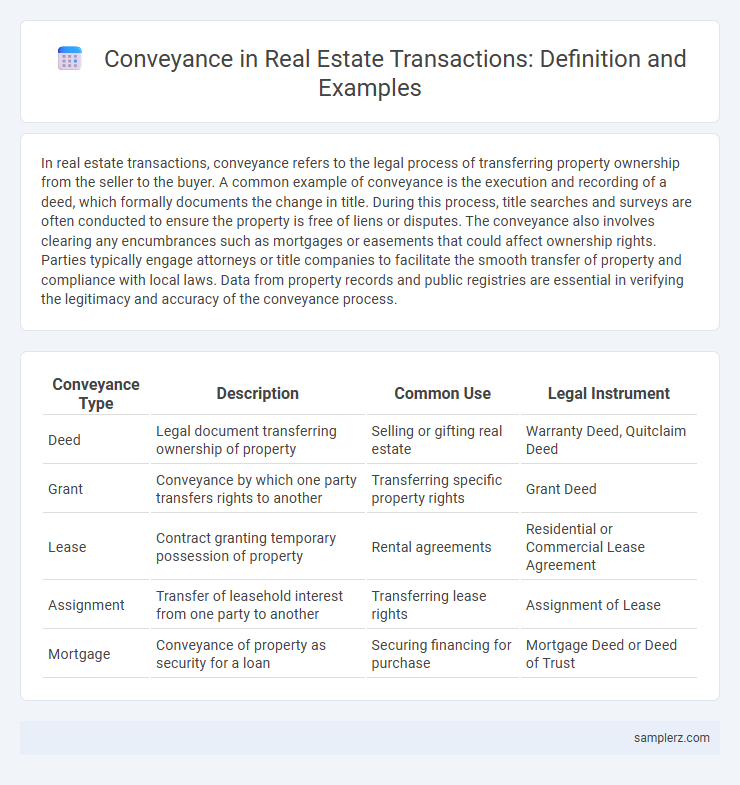In real estate transactions, conveyance refers to the legal process of transferring property ownership from the seller to the buyer. A common example of conveyance is the execution and recording of a deed, which formally documents the change in title. During this process, title searches and surveys are often conducted to ensure the property is free of liens or disputes. The conveyance also involves clearing any encumbrances such as mortgages or easements that could affect ownership rights. Parties typically engage attorneys or title companies to facilitate the smooth transfer of property and compliance with local laws. Data from property records and public registries are essential in verifying the legitimacy and accuracy of the conveyance process.
Table of Comparison
| Conveyance Type | Description | Common Use | Legal Instrument |
|---|---|---|---|
| Deed | Legal document transferring ownership of property | Selling or gifting real estate | Warranty Deed, Quitclaim Deed |
| Grant | Conveyance by which one party transfers rights to another | Transferring specific property rights | Grant Deed |
| Lease | Contract granting temporary possession of property | Rental agreements | Residential or Commercial Lease Agreement |
| Assignment | Transfer of leasehold interest from one party to another | Transferring lease rights | Assignment of Lease |
| Mortgage | Conveyance of property as security for a loan | Securing financing for purchase | Mortgage Deed or Deed of Trust |
Understanding Conveyance in Real Estate Transactions
Conveyance in real estate transactions refers to the legal process of transferring property ownership from seller to buyer through a deed. Key documents involved include the deed, title search, and settlement statement to ensure clear ownership transfer and avoid disputes. Proper understanding of conveyance safeguards buyers and sellers by confirming just title and legal compliance throughout the transaction.
Types of Conveyance Documents Used in Property Sales
Types of conveyance documents used in property sales include the deed, lease, mortgage, and title documents, each serving a unique function to transfer ownership or secure interest. The warranty deed guarantees clear title and protects the buyer against future claims, while the quitclaim deed transfers any ownership interest without warranties, often used in related-party transactions. Mortgages and lease agreements document financial obligations and occupancy rights, ensuring legal clarity throughout the property transaction process.
Steps Involved in the Conveyance Process
The conveyance process in real estate involves several key steps including drafting the sale agreement, conducting property title searches, and arranging for the settlement or closing where the ownership is legally transferred. Title searches ensure there are no liens or encumbrances, protecting both buyer and seller during the transaction. Finalizing the conveyance also requires registering the new ownership with the local land registry office to validate the transfer.
Example of Conveyance: Sale Deed in Residential Property
A sale deed is a legally binding document executed during the transfer of ownership in a residential property transaction, detailing the buyer, seller, and property specifics. This conveyance instrument ensures the seller transfers all rights, title, and interest in the property to the buyer upon full payment. Registered with the local sub-registrar office, the sale deed acts as primary evidence of ownership and is essential for property registration and future legal claims.
Conveyance in Commercial Real Estate: A Practical Illustration
Conveyance in commercial real estate involves the legal transfer of property ownership through a deed, often evidenced by a purchase agreement, title search, and due diligence process. For example, a developer acquiring a warehouse will initiate a conveyance by executing a deed that transfers title, accompanied by recorded documents ensuring clear ownership and compliance with zoning laws. This practical illustration underscores the importance of thorough documentation and legal formalities to secure commercial property rights.
Title Transfer: Key Example in Conveyancing
The key example of conveyance in real estate transactions is the title transfer, where ownership legally passes from the seller to the buyer through a deed. This process involves verifying the property's title, executing the deed, and recording it with the appropriate government office to establish the new owner's legal rights. Title transfer ensures clear ownership and protects buyers against future claims or disputes related to the property.
Conveyance Through Gift Deed: Real Estate Scenario
Conveyance through a gift deed in real estate involves the voluntary transfer of property ownership without monetary exchange, typically between family members. This legal process requires a duly registered gift deed, clearly specifying the donor, donee, and property details to ensure validity. Gift deeds often carry tax implications, necessitating careful documentation to avoid future disputes and ensure smooth transfer of title.
Mortgage Conveyance: Transaction Example Explained
Mortgage conveyance in real estate transactions involves transferring a mortgage interest from the borrower to another party, often occurring during refinancing or sale. An example includes a homeowner selling their property while the mortgage lender assigns the mortgage lien to the new buyer or another financial institution, ensuring lien continuity. This process requires formal documentation recording the transfer in public land records to maintain clear title and enforce loan obligations.
Example of Conveyance in Joint Property Transfer
A common example of conveyance in joint property transfer is the execution of a deed that transfers ownership from multiple sellers to one or more buyers. This deed can be a joint tenancy or tenancy in common conveyance, specifying the shared interests and rights of each party involved. Proper recording of this deed with the local land registry ensures legal recognition and protects the interests of all joint owners in the real estate transaction.
Common Pitfalls in Conveyance Transactions and How to Avoid Them
Failing to conduct thorough title searches often leads to undiscovered liens or encumbrances that can derail conveyance transactions. Ignoring proper documentation and legal requirements increases the risk of disputes over property ownership and transfer validity. Ensuring clear communication between all parties and employing experienced real estate attorneys helps avoid these common pitfalls and secures a smooth property conveyance.

example of conveyance in transaction Infographic
 samplerz.com
samplerz.com